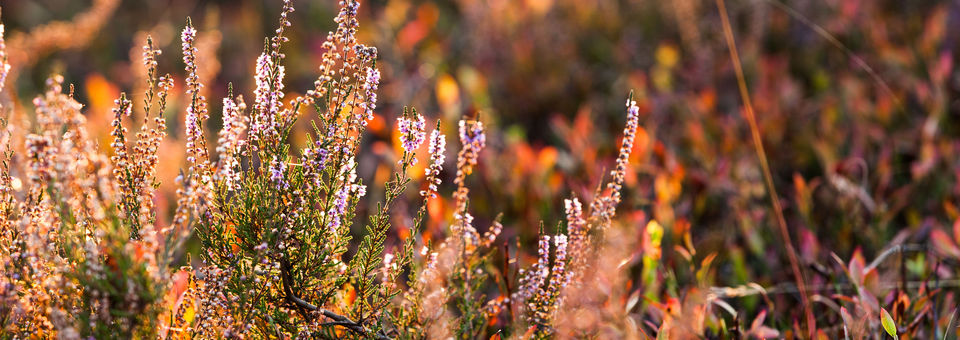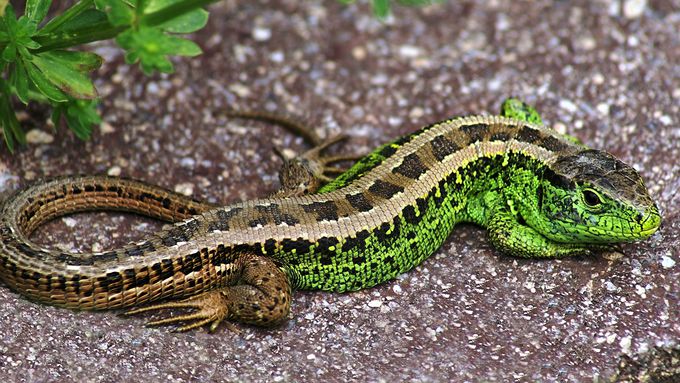Zauneidechse/Sand Lizard (Lacerta agilis) © Friedrich Böhringer, CC BY-SA 3.0
download picturemain content
Protected Species
LACERTA AGILIS (1261)
Sand Lizard
The Sand Lizard is a medium-sized, relatively clumsy-looking lizard. It reaches a head-body length of up to eleven centimetres and a total body length of up to 24 centimetres. The animals can be very different from each other in colouring and pattern. The basic colour of the upper head, back and tail is yellow-brown, grey-brown or brown. The sides of the body have a pattern with dark spots that partly consists of black-rimmed white eyespots. On the middle of the back and tail there is often a ladder-like pattern of bright lines and dark brown spots with brown spaces between. The males have a clearly thickened pope’s nose and have a striking green colour on the sides of the body and the throat, especially during the mating season. The ventral side is yellowish and spotless in the females, and green with black spots in the males. Subadult animals are single-coloured in brown with up to three rows of eyespots on each flank.
Habitat and biology
As an original inhabitant of the steppe, the Sand Lizard primarily inhabits dynamic inland dune areas in and along riverine floodplains. However, these natural dynamics almost do not exist any longer in Central Europe, also by the elimination of fires and the associated creation of open ground areas without vegetation. Therefore, the species is now mainly found in replacement habitats which are more or less shaped by humans: edges, aisles and clearings in mostly low-density coniferous stands (usually former oak-birch forest areas), often in connection with small interspersed heathland, dry heaths and nutrient-poor or dry meadows with more or less strong shrubs, embankments along railway tracks, roads or canals, quarries, ruderal areas, field boundary strips and waysides in connection with hedges, bushes or shrubs. Characteristic structures are sandy or stony dry soils, variable dense, partially completely missing vegetation, structures such as stumps, lying dead wood or heaps of stones, a certain slope of the terrain and exposure to the south as well as the presence of diggable, loose sandy areas with missing vegetation in sun-exposed position as sites for oviposition.
During winter, Sand Lizard hide in frost-protected hiding places. After hibernation, the diurnal animals leave their winter quarters from March to the beginning of April. From May, the females deposit nine to fourteen eggs in self-dug holes that are seven to eight centimetres deep on sun-exposed areas which are free of any vegetation. In favourable years, two clutches are possible. The young lizards hatch from late July to September or early October. While a large proportion of young animals are active until October and November, the adult animals start looking for their winter quarters already from the beginning of August.
The Sand Lizard is a very residential species which usually only uses small ranges with an area of up to 100 square metres. In the case of seasonal changes of territory, the size of the range can be to up to 1,400 (maximum 3,800) square metres. Dispersal presumably occurs via the subadult animals.
Sexual maturity usually sets in after the second overwintering. The maximum lifespan in the wild is 12 years for males and 18 years for females. However, most animals do not reach such a high age.
Occurrence
In North Rhine-Westphalia the Sand Lizard is classified as “Endangered“ (EN). The main distribution areas are the lowlands in the Münsterland area and in the north Rhineland.
In Lower Saxony the Sand Lizard is distributed more or less dispersed in all natural regions and is listed as “Vulnerable” (VU) in the current Red List (2013). The highest population densities are reached in the Luneburg Heath, the Weser-Aller Plains, the Weser-Leine Hills and the southern Ems-Hunte Geest. In the other areas the distribution is patchy.
Germany holds about 10 – 33 % of the entire distribution area of the subspecies Lacerta agilis agilis and thus has a high responsibility for the global preservation of this subspecies. For the subspecies L. a. argus more than 10 % of the entire distribution area are located within Germany. The distribution boundaries between the two subspecies runs through Schleswig-Holstein, the eastern part of Lower Saxony and the western part of Saxony-Anhalt towards Bavaria.
Threats
The changes to the landscape, caused by intensive agriculture and forestry, are the main causes for the decline of the Sand Lizard population and contribute considerably to the ongoing fragmentation and destruction of Sand Lizard populations. Reforestation or the conversion of heaths or neglected and dry grasslands, the backfilling and/or resumption of agricultural use, afforestation or overgrowth following the abandonment of quarries, the removal of structures that are necessary as cover and the fragmentation of habitats and isolation of populations through road construction are of particular importance for the decline. Other important factors are the loss of habitat through increasing eutrophication due to the use of fertilizers and scrubs overgrowing habitats more and more. Near settlements, dogs and cats running free may also cause an increased risk of predation.
Types of action
Basic implementation actions for the protection and improvement of the conservation status of the Sand Lizard are in particular the adaptation of cultivation plans to the habitat needs of the species, the abandonment or extensification of dry-sandy fields with marginal yields, the interdiction of reforestation within core areas of distribution or the opening of larger open areas as well as the creation or preservation of diverse natural forest edges with half-open character and unshaded marginal strips on both sides of forest paths. Suitable habitats can also be connected by using linear landscape structures (e.g. along power lines). Because of natural succession, maintenance of a biotope is necessary. It is also beneficial to maintain existing or create new vegetation elements as hiding places as well as to establish unshaded open areas for egg deposition on the ground. Discontinued railway lines should be used and preserved as linear habitats and connecting corridors.
Actions within phase 1 of the LIFE IP
In the first phase of the project, three actions will be implemented in North Rhine-Westphalia with the aim of improving the conservation status of the Sand Lizard. This primarily involves optimization actions for typical habitats of the species, such as the extension of Nardus grasslands and the restoration of dune habitats.
In Lower Saxony, thirteen actions will be implemented in the first phase of the project. The actions involve the (initial) restoration of habitats by removing seedlings as well as optimising habitats by creating structural elements such as clearance cairns and deadwood or optimising summer habitats.
Related Topics
additional information
Further Links
- Species profile „Sand Lizard“ – State Agency for Nature, Environment and Consumer Protection (LANUV NRW) (in German) (external link opens in a new window)
- Implementation notes for the protection of the Sand Lizard – Lower Saxony Water Management, Coastal Defence and Nature Conservation Agency (NLWKN) (in German) (external link opens in a new window)
- Species profile „Sand Lizard“ – German Federal Agency for Nature Conservation (BfN) (in German) (external link opens in a new window)
- German Prioritised Action Frameworks (PAF): Sand Lizard, page 124 – German Federal Agency for Nature Conservation (BfN) (in German) (external link opens in a new window)
- Red Lists and complete species list of Amphibian and Reptiles in Lower Saxony and Bremen (NLWKN) (in German) (external link opens in a new window)




